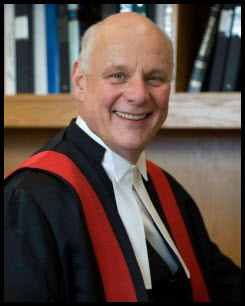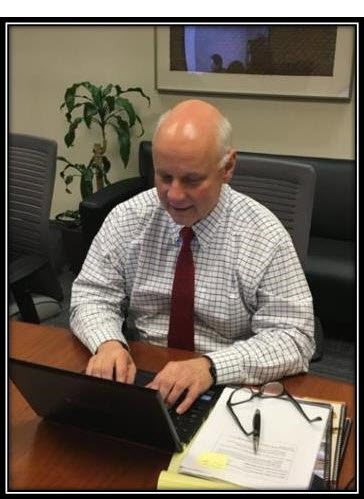Tom Crabtree—formerly the Chief Judge of the Provincial Court of B.C. and newly appointed a justice of the Supreme Court of B.C.—is known not only for his great accomplishments but also his abiding common touch and modesty. Because of the latter, he would likely shrink from the use of words like “promotion” or “elevation” to describe his move to the latest stage in his exciting career trajectory. The late D.M.M. Goldie, a former justice of the B.C. Court of Appeal, referred to that process—quaintly, genteelly and correctly—as being one of “translation”. That’s an old English usage that Tom would likely prefer because it does not carry with it any connotation of looking down on former colleagues. That said, those former colleagues shall continue to look up to him as they have always done, but henceforward (regrettably) from something of a distance.
Former Chief Judge Crabtree was always “Tom” to the other judges on the Provincial Court, both before and after he took the mantle of Chief. That, by itself, tells a great deal. In keeping with that approach, the newly sworn in Mr. Justice Crabtree shall be referred to here, throughout, with the same respectful informality.

Tom’s basics have been canvassed in press releases and news coverage accessible elsewhere and so the discussion of them in this tribute shall be appropriately brief. He was born in London, England in 1955, but was raised in the Fraser Valley. He earned his B.A. degree from UBC in 1978 and his LL.B. from UVic in 1983. Following graduation from law school, he practised criminal and civil litigation in and around Chilliwack until his appointment as a Provincial Court judge in 1999.
Tom is married to Brenda Crabtree, a much-respected artist of Nlaka’pamux and Sto:lo ancestry who is a cultural anthropologist and the Director of Aboriginal Programs at Emily Carr University of Art and Design. Tom and Brenda are the proud parents of two adult children—Andrew and Katelyn—both of whom are successful lawyers practising in Vancouver.
Contributions outside the Court
Tom became the Chief Judge of the Provincial Court in 2010 and served in that capacity until his appointment to the Supreme Court on May 4, 2018. He has always been very active in extracurricular responsibilities within the court and the court system generally. For example, he has variously:
- chaired a joint, national conference of the Canadian Association of Provincial Court Judges (“CAPCJ”) and the Provincial Court Judges Association of B.C. (“PCJABC”);
- chaired a joint, tri-lateral, international conference of the CAPCJ, the American Judges Association and the PCJABC;
- served as a director of the Continuing Education Society of B.C. (“CLEBC”);
- served as a member, and chaired committees, of the Canadian Council of Chief Judges (CCCJ);
- served as a member of the steering committee of Access to Justice B.C.;
- served as a member of the board of governors of the Ottawa-based National Judicial Institute (“NJI”);
- participated in a project of the Justice Education Society focused on the enhancement of the delivery of timely justice in the Magistrates Court of Guyana; and
- spoken frequently at conferences and symposia presented by CLEBC, NJI, the Canadian Institute for the Administration of Justice and the International Society for the Reform of the Criminal Law.
Judicial education
As can be seen, Tom has always been deeply committed to continuing legal education for judges. The Honourable Justice Adèle Kent, executive director of NJI, describes him as being “a passionate supporter of judicial education both for the members of his court and judges across Canada” and as “a leader in bringing relevant education in substantive law, judicial skills and social context to the judges of the Provincial Court”. Those views are shared by Pamela Williams, Chief Judge of the Provincial and Family Courts of Nova Scotia, who observed that she and her other colleagues on the Canadian Council of Chief Judges who deal with continuing legal education for judges “will miss Tom's thoughtful comments and incredible passion for the work he undertakes”.
Chief Justice Lise Maisonneuve of the Ontario Court of Justice agrees, saying “The Canadian judiciary benefitted not only from Justice Crabtree’s inspired and innovative leadership of the NJI and CCCJ, but also from his ability to quietly and capably teach small groups of new judges about, for example, the ins and outs of managing a courtroom. So many have benefitted from his contributions.”
Tom’s specific contributions to judicial education are too abundant to record here. Suffice it to say that he was a member of the PCJABC Education Committee from an early time in his judicial career and he chaired that committee from 2004 through 2008. He has also sat as a governor of NJI (as noted) and been actively involved as an instructor/facilitator at orientation programs offered annually to newly appointed provincial court judges from across Canada by NJI. Tom’s involvement in the aforementioned project with the Magistrates Court of Guyana required him to make several lengthy trips to that country where he assisted in the development of measures and standards to support the court in managing limited resources with a view to reducing time to trial. Tom has also hosted Guyanese Magistrates and other judicial delegates when they have undertaken study tours in Canada.
Indigenous litigants
Throughout his career on the bench, Tom has been equally committed to ensuring that the Provincial Court deals with indigenous litigants who appear before it in a sensitive and properly informed way. He has done so in part through his leadership in judicial education, ensuring that issues pertaining especially to aboriginal populations are well represented in the court’s twice-annual Judicial Education Conferences. But it hasn’t stopped there. For example, Tom has encouraged and overseen the development of indigenous and First Nations sentencing courts in New Westminster, Duncan, Kamloops, Merritt, Prince George and North Vancouver as well as aboriginal child protection conferences in New Westminster. Justice Adèle Kent summed it up well when she stated, “Tom has … led in addressing the response to the Truth and Reconciliation Commission insofar as it relates to assisting judges in having a better understanding of Indigenous Law”.
Innovation
Tom will also be remembered as a fearless innovator. He oversaw the introduction of a new trial scheduling model that has substantially reduced delays and improved the Provincial Court’s time-to-trial statistics in many regions. He led an extensive review of the court’s administrative structure, consolidating much of its administrative work into the hands of the members of four key committees. The many administrative regions that existed previously were collapsed into five. Regional Administrative Judges were appointed in each region to assist Tom and his two Associate Chief Judges in pursuing an approach to court administration that has made it more streamlined and efficient.
Tom also led the court in numerous initiatives to enhance its use of technology. Various projects are underway to reduce burdens and inefficiencies associated with paper record-keeping, for example. Those projects were commenced under his leadership. And Tom has also embraced technology as a means of engaging more effectively with members of the public—both by seeking their input and informing them about the workings of the Provincial Court through social media. As Acting Chief Judge Melissa Gillespie expressed it, “he believes strongly in creating stronger communities by public outreach and accessibility”. Acting Chief Judge Gillespie continues:

Those live, two-hour Twitter town halls, by the way, were a first in Canada. No judge (or Chief Judge) in Canada had ever engaged directly with the public in that way before. Chief Justice Maisonneuve notes, “These initiatives served to make the court more understandable to both the general public and those who come before the court.”
Personal attributes
This tribute to Tom began with passing references to his humility and proceeded from there to a fuller discussion of his many achievements and accomplishments over a long and distinguished judicial career on the Provincial Court of B.C. It seems only fitting that the tribute, now drawing to a close, should return to Tom’s humanity—to the personal attributes that have endeared him to, and attracted the respect and loyalty of, the many judges and court staff who have had the pleasure and privilege of serving under his leadership. Those human qualities have inspired many, in the last few days, to express words of appreciation and admiration for all that he has meant to them. There is, of course, too little space available to share all of those kind sentiments here, but a few examples will convey the flavour of what Tom’s departure has provoked in the way of grateful reflection on the part of the judges who have worked most closely with him as Chief.
Associate Chief Judge Susan Wishart comments on his “phenomenal capacity for work”. She says, “He put in long hours at the office, including most weekends, frequently travelled throughout the province and rarely took holidays. He was able to maintain this pace and his sunny disposition because he truly loved the work.”
Acting Chief Judge Gillespie, like many others, thinks of Tom as a “warm and humble person” who is “deeply committed to public service”. Former Associate Chief Judge Gurm Gill comments that of Tom’s many great qualities:
“… the one that really stands out in my mind is his tremendous ability to build and maintain relationships, both within and outside the court. Within the court, he interacted as a genuine ‘First among Equals’, reinforcing trust amongst our colleagues and boosting the court’s morale.”
Former Associate Chief Judge Nancy Phillips’ reflections are similar:
“What stands out for me about Tom is how he always aspired to fairness in his administrative decision-making during my time at the Office of the Chief Judge. He would give careful thought to every issue and attempt to come up with a response that was even-handed and likely to stand the test of time. The other attribute that I found noteworthy was that he never once responded to anything the Chief Judge’s job threw at him with any anger or upset. In sum, the judicial quality of serenity was always evident despite the pressures of the office.”
High praise indeed. And these are but a few examples.
Tom Crabtree has been greatly valued and admired as colleague and a leader. He has left his imprint and the court has advanced resolutely on many important fronts as the result of his solid judgment and fine example. His kind and steady guiding hand will most certainly be missed. All judges of the Provincial Court, together with court staff, join together in wishing Tom well as he turns the page and confronts the exciting new challenges that lie ahead. But beyond that, there is an expectation that, despite his new career, he will stay in touch. In other words, it is the fervent hope of all that he will not, so to speak, become “lost in translation”.

